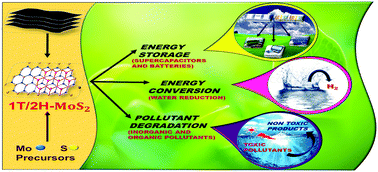One step towards the 1T/2H-MoS2 mixed phase: a journey from synthesis to application
Abstract
The development of effective and low cost-efficient strategies for energy storage and conversions as well as an eco-friendly environment to sustain is an important current issue. Over past few years, the concept of graphene has triggered research on various 2D materials, especially single as well as few-layered transition metal dichalcogenides. Owing to its extraordinary physicochemical properties and outstanding electronic features, MoS2 is a promising and benchmark material. In comparison to semiconducting 2H-MoS2 exhibiting active sites only on edges, the metallic 1T MoS2 possesses more electrochemically active sites (both on edges and basal surfaces), enlarged interlayer distance, high electronic conductivity, and chemical activity but has stabilization issues. In the 1T/2H-MoS2 mixed-phase heterostructure, where partial transformation occurs from the 2H to 1T phase, the kinetic barrier decreases and more electron transfer occurs, providing an increased number of active sites. In this case, the metastable 1T phase is stabilized due to the interaction of the 2H phase, thereby greatly boosting its catalytic activity. This review gives a comprehensive overview on the structure and various approaches for the fabrication of 1T/2H-MoS2. It also summarizes applications for energy conversion, storage, and pollutant abatement including hydrogen evolution via electro/photocatalysis, supercapacitors, lithium-ion batteries, lithium–sulfur batteries, as well as organic and inorganic pollutant degradation.

- This article is part of the themed collection: 2021 Materials Chemistry Frontiers Review-type Articles


 Please wait while we load your content...
Please wait while we load your content...